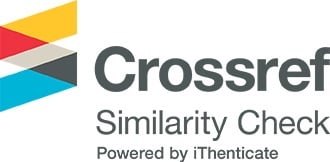Phát hiện Melon yellow spot virus tại Việt Nam bằng kỹ thuật RT-PCR
Các tác giả
DOI: https://doi.org/10.59294/HIUJS.34.2025.753Từ khóa:
bệnh virus, dưa lưới, gen nucleocapsid, Melon yellow spot virus, RT-PCRTóm tắt
Melon yellow spot virus (MYSV) là loài virus thuộc nhóm Tospovirus gây nên bệnh đốm vàng trên cây dưa lưới. Loài virus này lần đầu tiên được phát hiện tại Nhật Bản và hiện được ghi nhận tại nhiều nước trên thế giới. Mặc dù chưa có công bố chính thức về MYSV tại Việt Nam nhưng các triệu chứng bệnh điển hình đã được quan sát trên dưa lưới ở nhiều vườn trồng. Nghiên cứu này đã thiết lập quy trình phát hiện MYSV tại Việt Nam bằng kỹ thuật RT-PCR. RNA virus được tách chiết từ lá dưa lưới và sử dụng làm khuôn cho phản ứng RT-PCR nhằm khuếch đại phân đoạn gen mã hóa nucleocapsid (protein vỏ) bằng cặp mồi đặc hiệu, được thiết kế dựa trên vùng trình tự bảo tồn. Trình tự gen sau khi khuếch đại được dòng hóa và giải trình tự. Nhiệt độ bắt cặp mồi, nồng độ mồi tối ưu và giới hạn phát hiện của phản ứng cũng được xác định. Phản ứng RT-PCR đã khuếch đại thành công phân đoạn gen 186 bp, với độ tương đồng trên 98% so với các trình tự MYSV đã công bố. Nhiệt độ bắt cặp và nồng độ mồi phù hợp cho phản ứng lần lượt là 57oC và 0.2 µM cùng ngưỡng phát hiện ở mức 102 bản sao/µL. Cuối cùng, việc kiểm tra trên mẫu thực địa cho thấy có sự hiện diện của MYSV trong các mẫu thu thập tại Thành phố Hồ Chí Minh.
Abstract
Melon yellow spot virus (MYSV) is a species of Tospovirus group that causes yellow spot disease in melon. It was first detected in Japan and is now recorded in many countries worldwide. Although there has been no official report on MYSV in Vietnam, typical disease symptoms have been observed on melon in several fields. This study established a detection method for MYSV in Vietnam using RT-PCR. Viral RNA was extracted from melon leaves and used as a template for RT-PCR to amplify the nucleocapsid protein gene segment using specific primers designed based on conserved sequence regions. The amplified gene sequence was cloned and sequenced. The optimal primer annealing temperature, primer concentration, and detection limit of the reaction were also determined. The results showed that the RT-PCR reaction successfully amplified a gene segment (186 bp), which is 98% homologous to published MYSV sequences. The appropriate annealing temperature and primer concentration were 57oC and 0,2 µM, respectively, and the detection limit was 102 copies/µL. Finally, testing on field samples showed the presence of MYSV in samples collected in Ho Chi Minh City.
Tài liệu tham khảo
[1] K. Kato, K. Handa, M. Kameya-Iwaki, “Melon yellow spot virus: a distinct species of the genus Tospovirus isolated from melon,” Phytopathology, vol. 90, no. 4, pp. 422-426, 2000. DOI: 10.1094/PHYTO.2000.90.4.422.
[2] S. Takeuchi, Y. Shimomoto, and K. Ishikawa, “First report of melon yellow spot virus infecting balsam pear (Momordica charantia L.) in Japan,” J. Gen. Plant Pathol, vol 75, no. 2, pp. 154-156, 2009. DOI: 10.1007/s10327-009-0143-7
[3] S. Yamasaki, S. Okazaki, and M. Okuda, “Temporal and spatial dispersal of melon yellow spot virus in cucumber greenhouses and evaluation of weeds as infection sources,” Eur. J. Plant Parthol, vol. 132, pp. 169-177, 2012. DOI: 10.1007/s10658-011-9860-9
[4] C. H. Chao, T. C. Chen, Y. C. Kang, J. T. Li, L. H. Huang, and S. D. Yeh, “Characterization of Melon yellow spot virus Infecting Cucumber (Cucumis sativus L.) in Taiwan,” Plant Pathol. Bull., vol. 19, no. 1, pp. 41-52, 2010. DOI: 10.5555/20113039960.
[5] T. C. Chen, Y. Y. Lu, Y. H. Cheng, C. A. Chang, S. D. Yeh, “Melon yellow spot virus in watermelon: a first record from Taiwan,” Plant Pathology, vol 57, no. 4, 2008. DOI: 10.1111/j.1365-3059.2007.01791.x.
[6] P. Chiemsombat, O. Gajanandana, N. Warin, R. Hongprayoon, A. Bhunchoth, and P. Pongsapich, “Biological and molecular characterization of tospoviruses in Thailand,” Arch. Virol ., vol. 153, pp. 571-577, 2008. DOI: 10.1007/s00705-007-0024-3.
[7] Q. S. Gu, H. J. Wu, H. Y. Chen, X. J. Zhang, M. Z. Wu, D. M. Wang, and T. J. Liu, “Melon yellow spot virus identified in China for the first time,” New Disease Reports, vol. 25, no. 7, pp. 2044-0588, 2012. DOI: 10.5197/j.2044-0588.2012.025.007.
[8] D. F. Quito-Avila, E. L. Peralta, R. R. Martin, M. A. Ibarra, R. A. Alvarez, A. Mendoza, J. Ochoa, “Detection and occurrence of melon yellow spot virus in Ecuador: an emerging threat to cucurbit production in the region,” Eur. J. Plant Pathol., vol 140, pp. 193-197, 2014. DOI: 10.1007/s10658-014-0454-1.
[9] H. Wu, M. Liu, W. Li, M. Wang, J. Xiu, B. Peng, and Q. Gu, “Development and application of droplet digital PCR assay for the detection of Watermelon silver mottle virus and Melon yellow spot virus,” Horticulturae, vol. 10, no. 3, p. 199, 2024. DOI: 10.3390/horticulturae10030199.
[10] R. Zeng, L. H. Xu, S. G. Gao, X. H. Ni, C. L. Chen, J. C. Chen, and F. M. Dai, “One-step reverse transcription loop-mediated isothermal amplification assay for rapid detection of Melon yellow spot virus,” Eur. J. Plant Pathol., vol. 145, pp. 119–124, 2016. DOI: 10.1007/s10658-015-0821-6.
[11] A. Kanapiya, U. Amanbayeva, Z. Tulegenova, A. Abash, S. Zhangazin, K. Dyussembayev, and G. Mukiyanova, “Recent advances and challenges in plant viral diagnostics,” Front. Plant Sci., vol. 15, p. 1451790, 2024. DOI: 10.3389/fpls.2024.1451790.
[12] A. Staroscik, “Calculator for determining the number of copies of a template” [Online]. Available: http://cels.uri.edu/gsc/cndna.html, Accessed: Jan. 26, 2018.
Tải xuống
Tải xuống: 109











